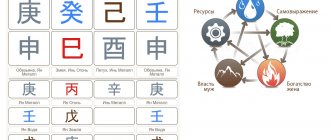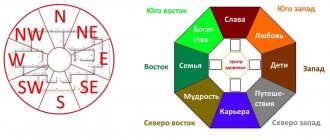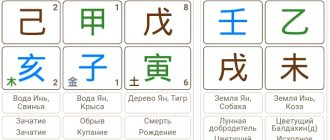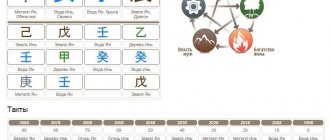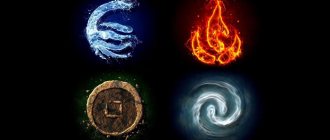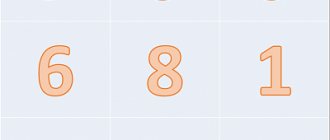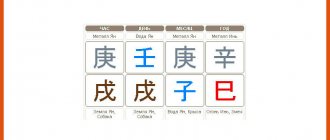“The Four Pillars of Destiny is an ancient Chinese art that allows us to immerse ourselves in the great mystery of life using the date of our birth.
Man is a rational being. As soon as he begins to think, he begins to ask questions. What is a sense of life? Is life on Earth governed by any laws? After several thousand years of thought and observation, the Chinese have accumulated a vast knowledge of the relationships between human life and the universe.
Understanding these relationships gives us a powerful tool to unlock our destiny. This tool is the Four Pillars of Destiny. By breaking down our birth date into its simplest elements and analyzing the interactions of these elements with the cyclical changes in the universe, we can predict our destiny.”
Raymond Law
Pillars of Destiny
Pillars of Destiny - show the influence of the Elements at the moment of human birth.
The time of birth is represented in the form of four pillars - the pillar of the year, the pillar of the month, the pillar of the day and the pillar of the hour.
Each pillar consists of two elements - the heavenly trunk (upper hieroglyph) and the earthly branch (lower hieroglyph).
In total there are ten heavenly trunks (5 Yin elements and 5 Yang elements) and twelve earthly branches (12 animals which also correspond to one of the elements).
Heavenly Stem of the Day Pillar - represents Personality. The remaining elements show the environment and areas of life.
It is important to determine the strength of this element relative to the other seven elements, in order to identify redundancy or deficiency and subsequently bring it into harmony. Only after we correctly determine the strength of the Personality Element will we be able to find out which elements are favorable for it and which are not.
Strength is determined by two factors - the season in which a person was born and the amount of the same and nourishing elements.
In order to bring a personality and its destiny into harmony, a strong personality needs elements that suppress or release its excess strength, and a weak personality needs supporting (the same) and feeding (generating) elements.
What to pay attention to when calculating?
The ancient sages spent decades identifying the cyclical nature and results of the interaction of external and internal factors. Therefore, understanding the entire system is not an easy task. Here are some tips to help you find out accurate and truthful information about yourself:
To find out what the influence of one element was on a given day, all five are considered. This will make it possible to analyze the position of the elements relative to others and reveal whether other forces have intervened in the structure of a person’s future destiny.
Each pillar affects 10 years of a person's life. Therefore, it is not recommended to change anything for yourself based on the first values. Only by counting the required number of cells and recognizing which interpretation correlates with the present and future can any conclusions be drawn.
Even if a person is one hundred percent confident in his abilities, a consultation would not hurt him. An experienced follower of Chinese wisdom will not only be able to help with the calculation of the four pillars of luck, but also give advice on changing the future.
How to determine family relationships and other aspects of life
Houses - according to the position of the elements in the four pillars
| Hour | Day | Month | Year |
| Son | Personality | Father | Grandfather |
| Daughter | Spouse) | Mother | Grandmother |
Stars: in relation to the personality element
For men:
- Mother is the element that gives birth to personality
- Father is an element destroyed by personality
- Descendants are an element that destroys personality
- The wife is an element destroyed by the personality (the same as for the father)
- Siblings - Same element as personality
For women:
- Mother is the element that gives birth to personality
- Father is an element destroyed by personality
- The husband is an element that destroys personality
- Descendants are an element generated by a person
- Siblings - Same element as personality
The top lines depict Wu Yaoban's birth date in the form of the Four Pillars of Destiny. The bottom lines represent the "pillars of luck" derived from the date of birth. The numbers above each pillar indicate the age of the person falling under its influence. For example, the number “4” above the first pillar D (written from right to left) means that this pillar ruled the luck of Wu Yaoban from the ages of 4 to 14 years, when the second pillar C came into effect o Each pillar of luck controls a period lasting 10 years. The Heavenly Stem covers the first five years of this period, and the Earthly Branch covers from the 6th to the 10th year. For the convenience of readers, the corresponding element from Table 7 is written under each Chinese character. As stated earlier, Wu Yaoban belonged to the category of overly strong Wood, since his date of birth clearly expressed the elements of Wood and Water in the absence of Metal, which controls the energy of Wood. Having determined the predominant aspects of a person’s character, one can assess which element will have the most beneficial effect on him and bring good luck. It should be remembered that the principles of balance and harmony lie at the core of Chinese culture. An excess of anything is contrary to the cosmic order, so certain actions must be taken or other elements brought in to restore balance. The general rule is that a weak Wood needs Water and Wood for support. On the other hand, a strong Wood needs Metal, which will control it, and Earth, which will release its excess energy. Similar rules generally apply to the usual date of birth. But Wu Yaoban was such a noble man that his birth date was also extraordinary. The Wood element in her is extremely strong. If his path was blocked by Metal and Earth, this would only lead to clashes and conflicts - that is, to greater disharmony. Therefore, in this case, it is best to “follow the trend” and allow the Wood to grow and develop to its full potential, avoiding any obstacles (in the form of Metal and Earth) in its path. So, Water and Wood were natural allies of Wu Yaoba-
nya, and Metal and Earth are his enemies. Since Fire gives birth to Earth and is in conflict with Water, it was also considered inauspicious. By studying the configuration of the four pillars and identifying the favorable and unfavorable elements, we only get a general idea of a person's appearance and potential. To observe more closely the fate of a person throughout his life and predict the ups and downs, we must study what influences he is exposed to from year to year. Each year brings exposure to different elements, which we can check using the Xia calendar (see Table 7). Each Chinese character from the Xia calendar represents one of the basic elements. Since the year is represented by two hieroglyphs, it brings with it the influence of two elements. For example, 1989 was the year of “Earth over Fire”, and 1991 was the year of “Metal over Earth”. These elements influence the Four Pillars of Destiny of every person and bring good or bad changes depending on their interaction. Now let's return to Wu Yaoban and see how the annual influences caused his rise and fall in the political arena. Metal and Earth adversely affected Wu Yaoban's career and led to his death. In 1967 (the year of Fire and Earth), when he was approximately 52 years old and his "pillar of luck" was ruled by Fire, he would be removed from all his posts and sent into exile by the "guardians of the cultural revolution." In the next two years (the years of Fire and Metal), Wu Yaoban was forced to live in a stable and suffered great hardships. Although 1987 was the year of Fire and Wood, the second element was consumed by strong Fire. Wu Yaoban was 72 years old and under the influence of the "fortune pillar" of Fire and Metal. In January (the month of Metal and Fire) he was again removed from power during a campaign against “bourgeois liberalism.” In 1989 (the year of Fire and Earth), Wu Yaoban was under the influence of the “pillar of luck” of Metal and Earth. He died in April (the month of the Earth), and this happened on the morning of the 15th, when Fire and Metal completely absorbed the element of Wood. It is interesting to note that the Empress Dowager, who had a similar date of birth, died in 1909 - ^1? - which was also the year of Earth and Metal.
28. THE RISES AND FALLS OF ZHAO ZI YANG
The study of the Four Pillars of the Fate of statesmen is of great interest, since their rise and fall are closely related to the destinies of nations. This is especially true in China, where power is highly centralized and in the hands of a few people. However, there is great difficulty in determining the exact date of birth of Chinese leaders. The only source of information is their biographies, which are sold in bookstores. But since the age of these figures usually exceeds 70 years and they were born in an era of revolutionary upheavals, the accuracy of the information provided is very doubtful and needs to be carefully verified. One interesting example is the birth date of Zhao Zi Yang, the former General Secretary of the Chinese Communist Party. According to the biography, Zhao Zi Yang was born on October 17, 1919 according to the Western calendar. The date of his birth, represented in the form of the Four Pillars of Destiny, is depicted in Fig. 51a. We can see that Zhao Zi Yang was a Water person born in September, which belongs to the Earth season. Since the Earth destroys Water, and the element of Wood, manifested in the pillars of the day and month, also absorbs a significant part of the water energy (Water gives birth to Wood), we can characterize Zhao
Zi Yan as a "man of weak water". Further, if he were born between 21.00 and 23.00 (hours of Metal and Water), his Water would still be too weak to represent such a powerful leader. It is therefore likely that the October 17, 1919 date of birth given in his biography is taken directly from the Chinese lunar calendar. Then the “pillars of fate” will look as shown in Fig. 516. This new configuration represents a powerfully built and tall Tree man, whose appearance is more similar to Zhao Zi Yang. There are good reasons to believe that his second date of birth is more accurate. A Water person, especially if we are talking about weak Water, usually has a round shape, a large layer of subcutaneous fat and weak muscles. Zhao Zi Yang had a tall, tightly built figure, more like the physique of a “strong tree” man. Thick lips indicate the presence of a strong Fire element in the four pillars. Fire is absent in the configuration in Fig. 51a, but shown in Fig. 516. A Water person usually has a round or square face. Zhao Zi Yang's elongated oval face indicates the combination of Fire and Wood, as indicated in Fig. 516. The man of “weak water” in fig. 51a is not a leader, but a follower, unlike the "strong Tree" person who belongs to the yang category - much like Wu Yao-ban. As mentioned in the previous chapter, the Yang Tree is often compared to a strong and unbending tree trunk. One interesting aspect of the four pillars is that they also reveal a person's relationship with his family members. In the biography of Zhao Zi Yang, he was the only son of a wealthy landowner. As a child, Zhao Zi Yang received a communist education in a rural school and met some members of the Communist Party. In his youth, he joined the fight against the nationalists and set up a refuge in his home for persecuted communists. This proves that Zhao Zi Yang's father had a good relationship with his son and supported him. Such a close connection between son and father can be seen through the analysis of Fig. 516. In the family plan, the annual pillar symbolizes the generation of the grandfather, the monthly pillar symbolizes the generation of the father, and the daily pillar symbolizes the generation of the person in question. The hour pillar symbolizes descendants. In the monthly pillar in Fig. 516, like the daytime, is dominated by Wood, so we can conclude that Zhao Zi Yang's father shared his son's beliefs. However, in Fig. 51a Wood predominates in the monthly pillar, and Water predominates in the daily pillar. Water gives birth to the Tree and supports it, but since it is weak, the father (Tree) does not help his son (Water), drawing off the already weak energy of Water. This is not consistent with Zhao Zi Yang's biography and is a good example of reconstructing and confirming a person's biography according to the Four Pillars of Destiny. By determining the more likely birth date of Zhao Zi Yang, we can test how accurately the Four Pillars of Destiny reflect his ups and downs in politics. To do this, we need to list the “pillars of luck,” each of which determines a person’s luck for 10 years. The upper character usually predominates in the first five-year period, then control passes to the lower character. The complete set of Zhao Zi Yang's "pillars of fate and luck" is depicted in Fig. 51c. The configuration shows that Zhao Zi Yang is a "Wood Man" of the yang category. A tree needs Water to support its growth. Born in winter, when Water is in its prosperous phase, the “Wood man” receives sufficient support. On the other hand, the element of Fire is clearly manifested in the four pillars, depleting the energy of Wood. Comparing the strength of all elements, we come to the conclusion
water, that Wood is well balanced: on the one hand, it enjoys the support of Water, and on the other, it has Fire to release its energy. This configuration indicates great intelligence and resourcefulness. A person with balanced four pillars is nevertheless susceptible to the influence of the “pillars of luck”, which can upset the balance and lead to ups and downs in life's path. In the case of Zhao Zi Yang, we see that Water brings him good luck by nourishing the Wood that dominates his personality. Metal is also favorable for him, as it generates Water. On the other hand, Fire and Earth weaken Wood and bring it bad luck.
Zhao Zi Yang married in 1940 (the year of Metal), when he was 21 years old and under the influence of the “fortune pillar” of Water and Metal. In 1943 (the year of Water) he was still under the influence of the “pillar of luck” of Water and Metal. He led the Communist army, which defeated the nationalists, and took a strong position in the Communist Party of the People's Republic of China. Between the ages of 20 and 30, Zhao Zi Yang continued to play an active role in the communist movement, especially strengthening his position during the civil war. His party career rose to new heights in 1960 (the year of Metal and Water) when he was appointed general secretary of Guangdong Province. He was 41 years old at the time and was under the influence of the "pillar of luck" Metal. Luck turned away from him in the Year of Fire (1966), when the “cultural revolution” began. In 1967 (another year of Fire and Earth), he was purged by the Party and, after house arrest, was imprisoned in Guangdong. During these dark years, Zhao Zi Yang was under the influence of the Earth's "fortune pillar". In 1972 (the year of Water), Zhao Zi Yang was rehabilitated and again took the post of General Secretary of the Communist Party of Guangdong Province. The next period of Metal and Water (1980 - 1984) brought him to a new peak in his career. In 1980, he was appointed a member of the Politburo of the CPC Central Committee and reached the last step to the post of General Secretary of the Communist Party. In 1989, Zhao Zi Yang was under the influence of the "pillar of luck" of Fire. This year was 2 Sa (year of the Snake). The month from May 5th to June 6th was again. The repeated appearance of the hieroglyph “C” in May 1989 is striking. This character belongs to the Fire element and conflicts with the Water element in the four pillars of Zhao Zi Yang. The combined power of the Snake was so great that it destroyed the strengthening influence of Water and undermined the balance of the four pillars. This month was disastrous for Zhao Zi Yang and led to his death in 1989.
29. IN SEARCH OF THE DATE OF BIRTH OF Deng XIAOPING
In 1989, many rumors circulated related to the fate of Deng Xiaoping. Because of his long withdrawal from public politics, suspicions arose, which were invariably refuted by his reappearance when, with his usual energy, he met with foreign delegations and statesmen. There is a strong temptation to compare these rumors with Deng Xiaoping's Four Pillars of Destiny, which often helps to determine a person's luck and shed light on the state of his health. It is widely known that Deng Xiaoping was born on August 22, 1904, but the hour of his birth has never been mentioned. Many experts and researchers in the field have assessed the available evidence and are divided on the issue. Most believe that he was born in the morning shortly before noon, which gives the configuration shown in Fig. 52a.
It can be seen that Deng Xiaoping is an “Earth man”, born in autumn, when Metal and Water are in their time of development and flourishing. If we look at the first three pillars (year, month and day), we will not find the element of Fire supporting the Earth (Fire gives birth to the Earth). Therefore, Deng Xiaoping belongs to the category of “weak Earth”, which especially needs the support of Fire. Since Fire is absent from the first three pillars, it is logical to assume that it is expressed in a strong form in the fourth pillar so that a person can occupy a prominent position in the hierarchy of power. There is an opinion that Deng Xiaoping was born between 9 and 2 o'clock in the morning, since these hours provide the element of Fire, which is missing in the first three pillars. Based on the assumption that Deng Xiaoping is a "weak Earth" person and needs Fire for warmth and support, we can expect Fire and Earth to bring him good luck, and Metal and Water to bring him bad luck. Let us now turn to important periods in the life of Deng Xiaoping to verify the correctness of the estimate of his date of birth. For example, the years of the Cultural Revolution (1966 and 1967) were some of the darkest in his life, as he was removed from his posts and suffered severe hardships along with his family. If the above assumption is true, these years should have been characterized by the clear presence of Water and Metal. However, 1966 and 1967 were years of Fire, and Deng Xiaoping was under the influence of the "pillar of luck" of Earth and Wood. One effective method often used to confirm a birth date is to compare family history with the characteristics of a monthly "pillar of destiny." This allows us to reveal the nature of the relationship between a man and his father. In the case of Deng Xiaoping, his monthly "pillar of destiny" belongs to the strong Water and Metal elements, which are considered unfavorable for him. However, it is known that he came from a wealthy family and spent his childhood in luxury and comfort. The assumption of the date of birth does not stand up to scrutiny, so the period between 9 and 2 am should be considered unacceptable. Other researchers (they are in the minority) believe that Deng Xiaoping was born in the early morning of the same day, which gives an hourly "pillar of destiny" consisting of pure Water or pure Wood. In Fig. 526 shows the configuration of the four pillars based on births between 3:00 and 5:00. A characteristic feature of this set of four pillars is the absence of Fire, which gives support to the weak Earth; instead, there are strong elements of the Tree, suppressing and destroying the Earth. According to the theory, if the daily “pillar of fate” (i.e.
individuality) is extremely weak, he must completely submit to the strongest element and perceive its characteristics. This is called “submission to the leader.” In this case, the weak Earth has absolutely no opportunity to fight the strong Tree in the hourly “pillar of fate”, so the Earth submits and acquires the properties of Metal and Water, most strongly manifested in the four pillars. Everything that stimulates the Earth and contributes to its rebirth (Fire and Earth) brings bad luck to a person, and everything that supports the strongest elements (Water and Metal) brings him good luck.
Deng Xiaoping's birth period from 3 to 5 am meets the above criteria. The Fire Years (1966 and 1967) during the Cultural Revolution brought him failure, while the Metal Years (1980 and 1981) returned him to power and led to the fall of the Gang of Four. Based on the same assumption, the year of the Snake, when Earth and Fire are in the ascending phase, is unfavorable for Deng Xiaoping. It was this year (1989) that the tragic events took place in Tiananmen Square in Beijing.
| BACK | CONTENT | FURTHER |
Our site is a library premises. Based on the Federal Law of the Russian Federation “On Copyright and Related Rights” (as amended by Federal Laws dated July 19, 1995 N 110-FZ, dated July 20, 2004 N 72-FZ), copying, saving on a hard drive or other method of saving works located on This library is strictly prohibited . All materials are presented for informational purposes only.
Copyright © UniversalInternetLibrary.ru - free e-books
How to decrypt a card
If the map is built using a calculator, the result is 2 tables. They are called the Pillars of Fate and the Pillars of Fortune. Another name for them is “cycles” or “cycles”. The Pillars of Destiny card contains 8 signs. The number of fate signs varies depending on how many decades or “beats” the calculation is intended to take place. 8-10 cycles correspond to 80-100 years of life.
Decoding the results begins with an assessment of each of the elements of the map. The meaning of any of them may vary. Depending on its location and what symbols it is adjacent to, the element can mean a state of health, the influence of a relative, or have some other meaning. To understand the combinations and influence of elements, you need to have deep knowledge in this area.
4 Pillars of Destiny
The Pillar of Fate is formed by the Earthly Branch and the Heavenly Trunk. This combination gives one of the 5 elements of Yin or Yang character. It is assumed that each element influences the character of one of the facets of personality: self-expression, resources, environment, money, power. There are 8 elements in total in the map. Each of them has their own role in fate.
By analyzing the Pillars of Destiny and viewing them from different points of view, the following data can be obtained:
- individual qualities and personality characteristics;
- abilities and the possibility of their implementation in the professional field;
- family relationships;
- health status and potential problems;
- defining life events;
- appearance, distinctive features.
Pillars of Fortune
The Pillars of Fortune map is a table consisting of 10 columns, each of which represents a ten-year cycle, or “beat”. Thus, 100 years of life are considered. Decoding the map provides information about the presence of successful or unsuccessful periods of life and what type of energy predominates in each decade. Thanks to this knowledge, you can get a clear picture of upcoming events.
The upper sign of the column - the Heavenly trunk - means the first half of the cycle, the lower sign - the Earthly branch is responsible for the second. The element corresponding to the sign governs the five-year period. Following one after another, these symbols form a life line, which marks the most or least favorable periods for choosing a profession, building a career, starting a family, or investing money.
Knowledge about the meaning of the Pillars of Luck will make it possible to strengthen the positive aspects of fate and prevent future troubles.
How to use the Ba Zi calculator
Calculators for calculating natal charts are clear and easy to use. You need to enter data: time, date of birth and place, gender in the appropriate fields. Click the “Calculation” button. The algorithm will produce a table reflecting the Pillars of Fate and the Pillars of Luck. The results can be printed. If you intend to share or post a link, you must click the “Save” button.
The calculator does not provide an interpretation of the map. Only a specialist can interpret the data obtained. Analysis of the map and presentation of the material takes several hours.
Ba Zi calculator.
How to make a map
You can compile and calculate a natal chart yourself, using detailed descriptions for beginners. To do this, the following data is needed: the hour and date of birth of the person for whom the card is intended. More accurate results can be achieved by adding information about gender and place of birth.
It is necessary to know the Chinese calendar, the difference between which and the Gregorian is that calculations in it are carried out in a different form, unusual for Europeans. In addition to this, you need to have knowledge that can be obtained both independently and in relevant courses. Studying special reference literature will help. The most reasonable thing is to entrust the drawing of the map to a professional or use the Ba Zi calculator.
The Ba Zi calculator can be found at the link: https://www.mingli.ru/calc.
LiveInternetLiveInternet
[Images of the 10 Heavenly Trunks] 1. Jia (Yang Tree) - emperor, mentor, image of a tall strong tree.
2. Yi (Yin Tree) - flower, shrub, flexible plant, twig, climbing vine.
3. Bin (Yang Fire) - a fiery fire or the sun. He is an open, warm person who easily gets into contact with others. He always speaks directly and frankly. What is on the mind is on the tongue, without choosing expressions and without accumulating anger. Sole of company. Honest, generous, distinguished by directness. The character is unstable - now it burns and scorches, after a few moments it is cold and unapproachable. Jumps of emotions.
4. Ting or Ding (Yin Fire) - the image of a candle or torch. these are the coals of a fire - there is no longer a flame, but the coals burn with a cherry fire - they give little light, but a lot of heat. Yin fire gives a flickering light, a person’s character is unstable, high sensitivity and sensitivity, intuition. With support, he can rock! Likes to be the center of attention, but not to show off, but to the point. He thinks a lot, there is a lot of internal tension, because... I’m not used to openly showing emotions, especially negative ones. Usually he puts everything inside. Sometimes tension can even manifest itself in physical shaking with strong excitement. Another image is a powder keg with a fire burning nearby - you never know when it might explode. The character is usually polite; it is quite difficult to learn to say “no”. Meticulous, sometimes to the point of being boring.
5. Wu (Yang Earth) - mountain, rock, stone or boulder. mighty Blacksmith with a hammer in his hands. This person expresses the very reliability and solidity. He is calm and confident in himself, in his own abilities, peaceful (because he is aware of his own strength and is not afraid), but woe to anyone who risks offending him or his friends. People of this sign are usually friendly and sentimental at heart. They are always ready to help others and make friends easily. They always thoroughly prepare for anything; thoroughness and unhurriedness are second nature to them. Due to their slowness, they can sometimes miss opportunities that require immediate action. A person is more determined than other signs to be in reality here and now. He is less concerned about past and future problems, his attention is on the current reality. Among the shortcomings - lack of flexibility and conservatism can make his life dry and joyless. But this does not upset him - the problems of one-day butterflies, whose whole life is one dazzling and bright moment, are alien to him. Such people can be extremely stubborn, and if they have a strong will, it is impossible to force them to deviate from their chosen path, even if it leads into the abyss. They have a persistent and indestructible Faith - if such a person believes in something or someone, nothing can shake him.
6. Ji (Yin Earth) - fertile soil; the image of the garden - a man of Yin land clearly and strongly expresses maternal instincts, he is caring, honest and kind. Like any soil, it is prone to conservatism. ; the image of arable land into which grains are scattered - it gives them shelter, helps them first germinate, and then nourishes them. The Yin element - the soil is soft and can take different forms - a person has a high adaptive ability.
7. Gen (Yang Metal) - heavy metal, diamond sword and steel. Silver Moon.
8. Xin (Yin Metal) - jewel, gold, knife, symbol of shiny metal jewelry. Image - Metal jewelry. a precious metal. Yin metal has the basic properties of metal - structure, strength, inward tendency (compressive energy). However, Yin metal is softer and more attractive. He is full of elegance and charm, which always attracts the attention of others. People of Yin metal are sybarites who strive to surround themselves with luxury and comfort. They are proud and very worried about their image, about how their environment perceives them. The desire to always look great leads to the fear of failure or losing face. Deeply material people, sometimes this leads them to extremes - greed. They may compromise their principles in exchange for monetary or material benefits. They strive to get everything now, they don’t want and don’t know how to wait.
9. Ren (Yang Water) - blue river, azure sea, ocean. it is a vast ocean or a huge waterfall. rapid streams of water, sweeping away everything in its path, very strong water. People of this element are often impulsive, inclined to act immediately and decisively. Pressure and power, energy is in full swing. Where he cannot take it head-on, he is able to bypass obstacles and enter from the other side, it is very difficult to stop once the decision has been made. High learning ability. The high importance of personal freedom does not accept restrictions.
10. Kwei (Yin Water) - dew, a transparent droplet, a fresh stream, light rain or fog.
What is a Ba Zi card?
The Ba Zi card is similar to the European zodiac horoscope, compiled in accordance with the signs of the Zodiac. This system has nothing to do with fortune telling. At its core, this is an energy information passport of the individual. The point of chart analysis is to draw a person’s attention to his problems, help him make the right life choice, and set him up for good luck. By correctly compiling and analyzing the natal Ba Zi chart, you can make positive changes in your life:
- establish relationships with others;
- adjust life attitudes;
- find the vector of activity that is most favorable for the individual;
- improve health by developing a conscious attitude towards it;
- receive recommendations on choosing a partner;
- determine favorable periods for important achievements;
- obtain information about possible developments.
This practice gives an understanding of the essence of events occurring in a person’s life. This system is called “Four Pillars of Fate and Luck”.
Pillars of Luck.
